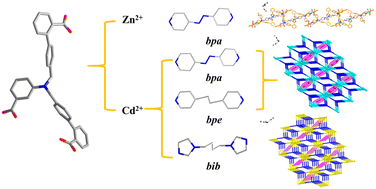Construction of ZnII/CdII-based MOFs containing a tripodal aromatic carboxylate ligand with unequal arms and their fluorescence detection for Cu2+ and Fe3+ cations†
Abstract
Four MOFs with mixed ligands, [Zn3(3-BABA)2(bpa)2(H2O)2]n (1), [Cd3(3-BABA)2(bpa)2]n (2), [Cd3(3-BABA)2(bpe)2]n (3), and {[Cd3(3-BABA)2(bib)(DMA)2]·H2O}n (4) (where 3-H3BABA = 4′,4′′′-(((2-carboxyphenyl)azanediyl)bis(methylene))bis(([1,1′-biphenyl]-2-carboxylic acid)), bpa = 4,4′-azopyridine, bpe = 1,2-bis(pyridin-4-yl)ethane, and bib = 1,4-bis(imidazole)butane), have been synthesized. They are characterized by single crystal X-ray diffraction, X-ray powder diffraction (XRPD), thermogravimetric analysis (TGA) and Fourier transform infrared (FT-IR) spectroscopy. In 1, two 3-BABA and two bpa bridge three Zn2+ ions to form a bicyclic [Zn3(3-BABA)2(bpa)2] unit which is further bridged by carboxylate groups with its adjacent units, resulting in a one-dimensional chain. In 2, 3 and 4, the [Cd3(CO2)6] units are bridged by six 3-BABA ligands into a three-dimensional structure. However, the adjacent [Cd3(CO2)6] units in 2 and 3 are doubly-bridged simultaneously by corresponding pyridyl ligands, while the adjacent [Cd3(CO2)6] units in 4 are singly-bridged simultaneously by corresponding pyridyl ligands. The luminescence sensing investigation indicates that compound 1 exhibits extremely sensitive and selective detection of Cu2+ with a detection limit of 0.363 μM, and compounds 2–4 show extremely sensitive and selective detection of Fe3+ with detection limits of 0.539 μM, 0.265 μM, and 0.748 μM, respectively. Competitive experiments in the presence of interfering cations with 1–4 revealed no major change in the quenching efficiency.



 Please wait while we load your content...
Please wait while we load your content...